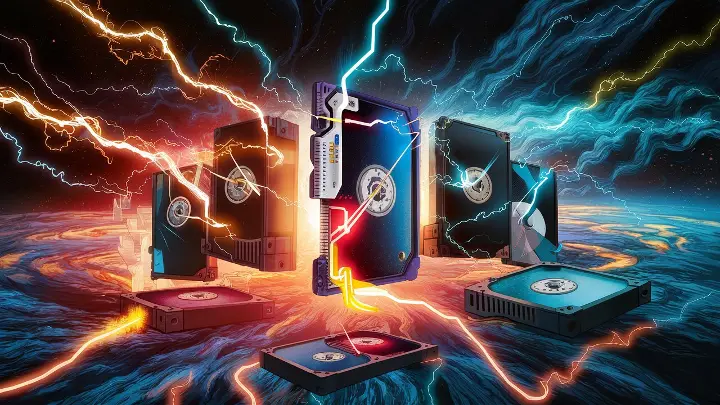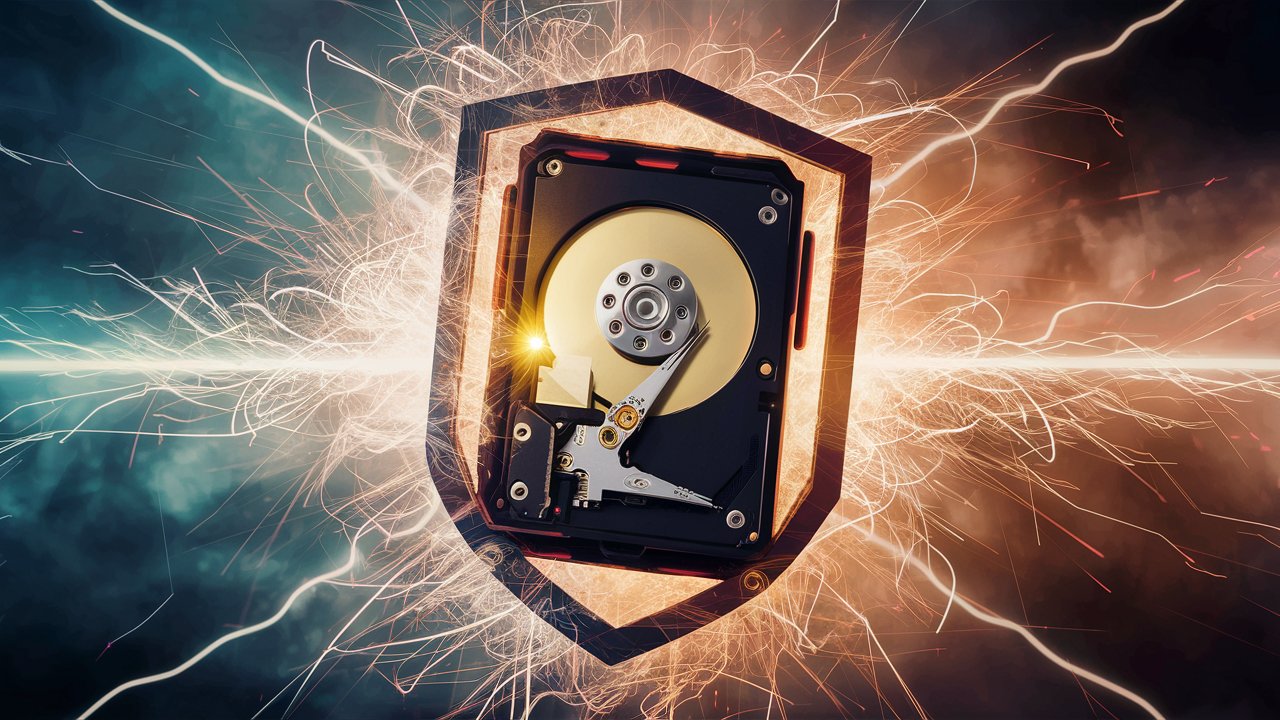Intro
Power surges can cause data loss, which is a frequent but sometimes overlooked threat to our digital lives. Power surges can have disastrous effects on data storage, leading to the unanticipated loss of crucial information kept on our devices. We'll examine how power surges affect data storage in this blog post, as well as strategies for protecting your important information against unplanned disasters.

Unveiling the Mystery Behind Power Surges
Even the most careful among us can be caught off guard by power surges, those brief but powerful electrical energy bursts that zigzag through our electrical infrastructure. These surges can originate from many different places. They can appear as the fury of a lightning strike, the whims of our utility systems, or even something as simple as turning on an energy-hungry gadget while we're inside our houses or workplaces. Power surges are similar to unexpected gales in that they are extremely strong and rapid, leaving little more than chaos in their wake when the right circumstances are met for destruction.
Our data storage devices' sensitive circuitry and components are particularly vulnerable to damage within this fleeting turmoil. It serves as a sobering reminder of the thin line that separates the volatile electrical environment that envelops our digital safe havens, where we keep our most valuable information. We can arm ourselves with the knowledge to defend our devices by understanding how these surges interact with them.
Even though these surges appear to occur randomly, there is some information available about where they come from. By understanding their origins and the routes they take, we can start to dissect the methods in which they cause their undetectable harm. The keys to strengthening our digital fortifications and changing our strategy from one of reaction to one of prevention lie in our comprehension of this phenomenon.

How Power Surges Interact With Data Storage Devices
Power surges and data storage devices interact through a complicated and frequently harmful performance of electrical forces. The sudden surge of excess voltage that defines a power surge interacts with the complex network of circuitry and components that enable data storage and retrieval rather than simply passing through these devices unopposed. This interaction has the potential to upset the delicate electrical balance inside, pushing parts over their breaking points and causing either one-time or cumulative damage.
A power surge's passage through a data storage device is not benign; rather, it causes an intrusive interruption. Hard drives may be physically damaged or misplaced due to their spinning disks and read/write heads, whereas solid-state drives may have data integrity issues or burned-out circuits. The magnetic or electronic blueprint where data is encoded may be tainted by this electrical harm, turning what was formerly an organized information repository into a jumbled tangle of misplaced data and broken connections.
The basic foundation of these gadgets' ability to store and retrieve our digital lives is in danger in this volatile trade. Beyond just being inconvenient, data corruption can destroy important information, professional records, and private memories. This exchange highlights the importance of the underlying dynamics and the need to protect our digital archives from unpredictable power surges.
The Invisible Threat: Data Corruption and Loss
Our digital existence is shadowed by the persistent threat of data corruption and loss, particularly when power surges occur. This sneaky danger works covertly, frequently going unnoticed until the harm is beyond repair. Imagine the situation where years' worth of digital photos, private correspondence, or important work initiatives disappear in an instant, victims of the indiscriminate route of a surge. Such losses have far-reaching effects that go well beyond simple discomfort; they can have a negative influence on one's emotional health, and professional productivity, and even result in large financial losses.
This hidden threat challenges our beliefs about permanence and dependability while highlighting how unstable digital data storage is. The digital strands that connect our personal and professional identities might be severed in an instant by a surge. The resulting data loss and corruption are a clear reminder of the built-in weaknesses in our digital storage systems, weaknesses that power surges can take advantage of with deadly efficiency.
More than just acknowledging it passively, addressing this invisible threat necessitates active engagement with risk-reduction tactics. The first stage in a comprehensive defense, which includes both technological solutions and an awareness of the worth and fragility of the data we sometimes take for granted, is to recognize the warning indications and potential triggers for power surges. The struggle against power surges, which pose invisible threats, is becoming increasingly important as we navigate the digital age and protect our digital legacy.

Protecting Your Data Against the Ravages of Power Surges
The deployment of surge protection devices becomes a strategic need to create a wall against the unseen attack of power surges. These protectors of the electrical domain keep watch over our most valuable digital assets, providing sanctuary from the unstable storms that aim to destroy the integrity of our data storage. In this situation, surge protectors show their true worth—not only as decorative pieces but as vital guardians that divert excess energy that could compromise our digital defenses.
A careful strategy is needed to integrate these security measures into our digital infrastructure. As any device linked to our network is a possible route for surge-triggered disasters, it is critical to guarantee extensive coverage. When choosing a surge protector, it's important to consider two factors: response time, which determines how quickly the protector can react to deflect an oncoming surge, and joule rating, which indicates how much energy it can absorb.
A deeper layer of safety goes beyond simply using surge protectors; it also involves closely examining the certification and build quality of these devices. Not all surge protectors are made equal, so it's important to look for ones that have passed stringent testing and have the approval of reliable standard-setting bodies. This careful selection procedure is similar to selecting a shield in combat, where one's armor might make the difference between winning and losing.
Deploying surge protection is an investment in safeguarding our digital legacy, not just a tactical move. We strengthen our defenses against the irrational whims of electrical disruptions by applying these preventive technologies with alertness, creating a stronghold for our data against unpredictability.

Common Causes of Power Surges and How to Mitigate Them
The electrical currents that sustain us have a subtle but profound impact on the environment of our everyday life. Power surges, which arise from seemingly benign activities and natural phenomena, offer a hidden yet severe hazard inside this electrical ecology. These disruptive events have a variety of causes, such as the dramatic display of lightning striking local infrastructure, the fluctuating utility grid supply, or the commonplace act of powerful gadgets suddenly consuming a large amount of energy. Even if they happen frequently, these occurrences can spiral through our electrical systems and try to get into the sacred space of our data storage devices.
As a result, mitigation turns into an exercise of planning and expectation. Installing whole-house surge protection creates a first line of defense by dispersing surge energy before it reaches the more vulnerable areas of our houses and electronics. Electrical systems must be grounded for excess energy to escape into space. This is a basic but effective defense against the whims of electrical fluctuations. Individual surge protectors are the last line of protection for the protectors of our digital domains, the many devices that hold the bits and bytes of our digital existence. When carefully selected based on their ability to both absorb and redirect surge energy, these devices create a protective network that shields our digital legacy from the unpredictability of power surges.
The Future of Data Storage: Innovations Reducing Surge Vulnerability
Moving forward, the light of technological advancement shines on the horizon of data storage. Devices that can naturally endure the wild vagaries of power surges are anticipated thanks to the development of novel materials and architectural designs. Superconductor research and nanotechnology are opening the door to storage options that can self-repair from small surge-related damages in addition to withstanding electrical interference. Real-time surge detection and reaction are possible with the integration of more intelligent, AI-driven power management systems within devices, reducing risk before it may cause data loss.
Additionally, the rapidly developing field of quantum computing presents an idea in which data storage functions on principles impervious to conventional electrical dangers. This new environment promotes the marriage of robustness and creativity, guaranteeing that our digital archives in the future will be resilient to the transient risks associated with power outages. We demonstrate our dedication to maintaining the accuracy of our data in an unpredictable environment by investing in the security of our digital footprint by keeping up with these improvements.